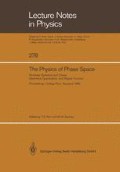Abstract
This article elaborates on a talk delivered by the first author at the First International Conference on the Physics of Phase Space (University of Maryland, 20–23 May 1986). It reviews briefly our still limited, but rapidly growing understanding of a dynamical process, the ionization of highly-excited hydrogen atoms by a microwave electric field. Classical dynamics explains surprisingly well many recent experimental results from Stony Brook, on which the article focusses. Some experimental results not well explained, however, appear to be essentially quantal in origin. These are just now beginning to be understood. New, detailed questions continue to arise as older questions are answered.
Access this chapter
Tax calculation will be finalised at checkout
Purchases are for personal use only
Preview
Unable to display preview. Download preview PDF.
References
From a vast literature we suggest A.J. Lichtenberg and M.A. Lieberman, “Regular and Stochastic Motion,” Springer-Verlag, New York (1983); articles by L.P. Kadanoff and by M.C. Gutzwiller in Physics Scripta, Vol. T9 (1985), a special volume on “The Physics of Chaos and Related Problems”; J.R. Ackerhalt, P.W. Milonni, and M.-L. Shih, Phys. Rep. 128:205(1985).
T. Hogg and B.A. Huberman, Phys. Rev. Lett. 48:711 (1982); Phys. Rev. A28:22(1983).
J.E. Bayfield and P.M. Koch, Phys. Rev. Lett. 33:258 (1974); J.E. Bayfield, L.D. Gardner, and P.M. Koch, Phys. Rev. Lett. 39:76 (1977); reviewed in P.M. Koch, J. Phys. (Paris), Colloq. 43:02-187 (1982).
J.G. Leopold and I.C. Percival, Phys. Rev. Lett. 41:944 (1978) and J. Phys. B12:709 (1979); D.A. Jones, J.G. Leopold, and I.C. Percival, J. Phys. B13:31 (1980); B.I. Meerson, E.A. Oka, and P.V. Sasorov, J. Phys. B15:3599 (1982); Soviet and other literature on this problem is reviewed in N.B. Delone, V.P. Krainov, and D.L. Shepelyansky, Usp. Fiz. Nauk 140:355 (1983) [Sov. Phys. Usp. 26:551 (1983)].
R.V. Jensen, Phys. Rev. A30:386 (1984).
J.G. Leopold and D. Richards, J. Phys. B18:3369 (1985).
J.G. Leopold and D. Richards, J. Phys. B19:1125 (1986).
O. Rath and D. Richards, in preparation.
From a growing literature, we suggest G.M. Zaslavsky, Phys. Rep. 80:157 (1981); see, also, many of the articles in “Chaotic Behavior in Quantum Systems: Theory and Applications,” edited by G. Casati, Plenum, New York (1985).
D. Delande and J.C. Gay, Phys. Rev. Lett. 57:2006 (1986).
P.M. Koch, in Ref. 3. D.R. Mariani and W. van de Water contributed importantly to the microwave ionization results presented in this reference.
K.A.H. van Leeuwen, G. v. Oppen, S. Renwick, J.B. Bowfin, P.M. Koch, R.V. Jensen, O. Rath, D. Richards, and J.G. Leopold, Phys. Rev. Lett. 55:2231 (1985); P.M. Koch, in “Fundamental Aspects of Quantum Theory,” A. Frigerio and V. Gorini, editors, Plenum, New York (1986).
P.M. Koch, in: “Rydberg States of Atoms and Molecules,” R.F. Stabbings and F.B. Dunning, editors, Cambridge University Press, New York (1983).
J.E. Bayfield and L.A. Pinnaduwage, Phys. Rev. Lett. 54:313 (1985) and J. Phys. B18:L49 (1985); J.N. Bardsley, B. Sundaram, L.A. Pinnaduwage, and J.E. Bayfield, Phys. Rev. Lett. 56:1007(1986); J.E. Bayfield, elsewhere in this volume.
J.G. Leopold and D. Richards, J. Phys. B (to be published, 1987).
P.M. Koch and D.R. Mariani, Phys. Rev. Lett. 46:1275 (1981).
K.A.H. van Leeuwen, P.M. Koch, 0. Rath, D. Richards, J.G. Leopold, and R.V. Jensen, in preparation.
K.A.H. van Leeuwen and P.M. Koch, in preparation.
R. Bluemel and U. Smilansky, Proceedings of Adriatico Research Conference on Quantum Chaos, Trieste, June 1986, to be published in Physics Scripts, 1987.
Structure in microwave experiments with helium Rydberg atoms has also been linked to avoided crossings of its Floquet eigenstater; see W. van de Water, K. van Leeuwen, P. Koch, and T. Bargeman, Bull. Am. Phys. Soc. 31:942 (1986).
R. Bluemel, U. Smilansky, P.M. Koch, K.A.H. van Leeuwen, O. Rath, and D. Richards, in preparation.
G. Casati, B.V. Chirikov, and D.L. Shepelyansky, Phys. Rev. Lett. 63:2525 (1984); G. Casati, B.V. Chirikov, D.L. Shepelyansky, and I. Guarneri, Phys. Rev. Lett. 57:823(1986).
S. Fishman, D.R. Grempel, and R.E. Prange, Phys. Rev. Lett. 49:509 (1982); Phys. Rev. A29:1639(1984).
J.N. Bardsley and M.J. Comella, J. Phys. B19:L565 (1986).
Author information
Authors and Affiliations
Editor information
Rights and permissions
Copyright information
© 1987 Springer-Verlag
About this paper
Cite this paper
Koch, P.M., van Leeuwen, K.A.H., Rath, O., Richards, D., Jensen, R.V. (1987). Microwave ionization of highly excited hydrogen atoms: Experiment and theory. In: Kim, Y.S., Zachary, W.W. (eds) The Physics of Phase Space Nonlinear Dynamics and Chaos Geometric Quantization, and Wigner Function. Lecture Notes in Physics, vol 278. Springer, Berlin, Heidelberg. https://doi.org/10.1007/3-540-17894-5_330
Download citation
DOI: https://doi.org/10.1007/3-540-17894-5_330
Published:
Publisher Name: Springer, Berlin, Heidelberg
Print ISBN: 978-3-540-17894-1
Online ISBN: 978-3-540-47901-7
eBook Packages: Springer Book Archive

